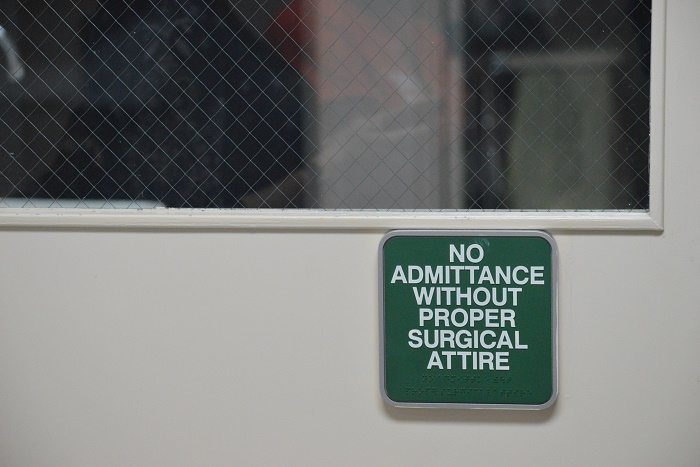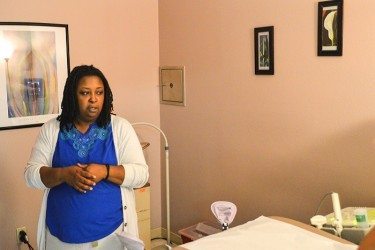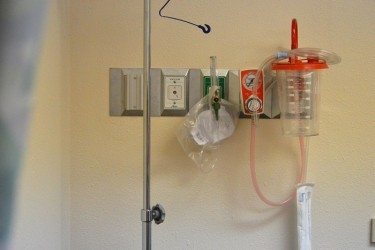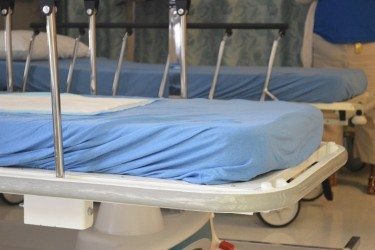The Institutionalization of Abortion Stigma: What Care at an Ambulatory Surgical Center Can Look Like
Under HB 2, Texas' omnibus anti-abortion law, doctors must fulfill medically unnecessary requirements just to stay open, forgoing a patient’s comfort.

It only takes a visit to one community clinic and one ambulatory surgical center to see how HB 2, Texas’ omnibus anti-abortion law, is taking its toll on patient care. Doctors must now fulfill medically unnecessary requirements just to stay open, forgoing a patient’s comfort.
This situation will only get worse if the Supreme Court lets HB 2 stand. The Court, when its term begins October 5, could take up a challenge from reproductive rights advocates to “determine whether Texas can force more than 75 percent of the State’s abortion clinics to close.” While we wait to hear from the Court, I’d like to share my experience of touring two clinics—one that was constructed before HB 2 and one that was built to comply with the restrictive law.
Whole Woman’s Health (WWH) is a feminist organization that offers comprehensive gynecology services for people, including abortion care. During my internship at NARAL Pro-Choice Texas, Marva Sadler, WWH’s director of Clinical Services, gave us a tour of the organization’s San Antonio clinic. Sadler led us around the facilities, as if we were patients, so we could get a sense of the experience, from sitting in the waiting room to recovering in the Aftercare room. WWH San Antonio creates a unique and individualized experience for people obtaining abortions, actively fighting shame and honoring their individual experiences through soothing purple walls and lighting, empowering artwork, rooms named after powerful women, and a comforting atmosphere.
The clinic visit starts with counseling and then a one-on-one consultation with the doctor who would be performing the abortion, to answer any questions and to provide total awareness of the patient’s various options. Family members and escorts are welcome to accompany the patient throughout the process, although the patient is also given confidential time alone with the clinic staff, who are well-trained to identify issues like coercion, domestic abuse, and human trafficking. The patient also watches the Whole Woman’s Health video, which leads the patient through the entire process of getting an abortion “from the moment a patient walks through the door to when she leaves from recovery.” The patient has many opportunities to ask questions, discuss their options, and think through what is best for them.

The operating room at the regular, non-ambulatory clinic is a small, intimate space with a lamp and two medical devices, an ultrasound system and a suction machine. The room is comforting and supportive, especially because an escort can act as a hand-holder throughout the process. The doctor’s patient-centered practice contributes to the warm atmosphere, as the patient and doctor have already been acquainted through counseling, and the doctor talks the patient through the procedure, explaining what is happening along the way. At WWH, they call this “verbicaine.” As Sadler described it: “Nine times out of ten, without any sedation, we talk patients through their procedures. We start a totally different conversation about something totally different, and then when they realize that the conversation is over, the procedure is over.”
The procedure is usually over within eight to ten minutes.
At the end, patients enter the Aftercare room: a space lit by lamps with purple blankets and lush reclining chairs. They can have “tranquili-tea”—a WWH-exclusive, specially brewed tea to help with cramping—use heating pads, and talk to staff and their escort(s).
“This is where the emotion happens,” says Sadler. Aftercare is where Whole Woman’s Health staff “really [get] to put their special touch in with patients, and this is where the difference happens. This is where they’re individualizing, and they get to make a difference in a life.”
Whole Woman’s Health erases stigma from the abortion process and transforms it into a wholesome experience centered on the patient’s needs. WWH’s staff are trained to break down the walls of abortion stigma in a safe, comforting and nonjudgmental environment, making sure they’re caring for the patient holistically from the time they walk into the clinic until after the procedure and follow-up appointment.
Unfortunately, restrictions like those in HB 2 have completely compromised WWH’s methods.
HB 2, among other things, requires that all abortion clinics meet the building standards of an ambulatory surgical center (ASC). Should this provision of HB 2 go into effect, only nine clinics would be able to serve all of Texas (see a comparison of the requirements here). After the Fifth Circuit Court of Appeals ruled to uphold HB 2’s provisions, Whole Woman’s Health, along with other Texas abortion providers and led by the Center for Reproductive Rights, took the law to the Supreme Court. The Supreme Court then granted a stay, blocking that provision of the law from going into effect while the Court decides whether or not to hear the case.
To comply with the state’s new restrictive abortion legislation, WWH constructed an ambulatory surgical center in 2010 that provides a vastly different patient experience. We toured that clinic, which is located across the parking lot from WWH’s regularly licensed abortion clinic, as well.
First entering the ASC clinic’s waiting room, we saw the same purple walls, but throughout the rest of the facility, it was stark white, an official ASC regulation. The atmosphere immediately transitioned into that of a shameful “asylum,” as Sadler put it. Notices and warnings were posted everywhere, where artwork might be if it were allowed. Alarm systems (or, as staff call it, “money hanging on the walls”) are plastered throughout the facility, rarely, if ever, used. There are internal alarm systems, hospital-grade fire alarm systems with sprinklers, a guest monitor, a generator monitor, and an emergency generator—all of which need to be tested and documented every day. These are extra obligations and extra money that are only a requirement of an ASC, adding nothing beneficial to the abortion procedure or to patient health and safety.

The preoperative room has bright, blinding overhead lighting that makes you feel like you’re being interrogated. Many different contraptions and systems are wired across and through the walls, including different gases, chemicals, and canisters.
In the five years that WWH has had this ASC, Sadler says, they haven’t needed to use this equipment once.
In spite of this, the canisters have to be replaced when they get old, the cords to the equipment have to be checked everyday, and IV access has to be maintained, whether the patient wants sedation or not.
Another requirement that jeopardizes the patient’s comfort is that they have to get completely undressed and put on a hospital gown, surgical booties, and a surgical bonnet. Patients aren’t allowed to walk around like they would in a regular clinic, but have to lay on a gurney, wheeled to and from the operating room. When abortion is treated like a dangerous surgery, it takes away the independence and strength of the decision to have one. Obviously, these provisions are necessary for facilities that provide intensive, invasive procedures, but for abortion care, this is absolute overkill and a waste of money, not to mention an uncomfortable experience for the patient. It serves to do nothing but further stigmatize one of the safest procedures available in health care.
The halls of the ASC clinic at Whole Woman’s Health of San Antonio consisted of other specific requirements that don’t seem to have any real use: a pharmacy with required medication that doctors there have never used and do not need to provide abortions (“When these meds expire, we just throw them away and order more,” says Sadler), crash carts stocked with medication that can be $200 a bottle, male and female locker rooms, two color-coded janitor’s closets, and a blanket warmer. ASC requirements even took away WWH’s special touch of providing purple blankets; the blankets have to be white.

In the ASC clinic, the process is much more intimidating. It was massive, with bright “alien eyes” staring down at us, filled with complex machines, even though abortion care only requires the ultrasound and suction machines. According to Sadler, the patient is strapped down onto the table—nude in a 60-degree facility—arms restricted with straps on both sides of the table that keep her from moving. The only people allowed in the room are the doctor, registered nurses, and surgical techs. Because the patient is not allowed to have an escort in the room, no one is there to hold her hand. As the doctors are maintaining all of the different equipment, that verbal connection and emotional touch found across the street at the non-ASC clinic is lost here.
“[The patient] is absolutely alone because there is no one there to hold her hand throughout the whole thing. It’s horrible,” says Sadler, staring down at the ASC clinic’s emotionless surgical table. “It’s really hard to watch. It’s night and day between this and the [other] clinic.”
Because the doctor can’t reasonably talk the patient through the procedure because of the masks on her face and the loud air pressure system, Sadler says, “there’s no conversation at all. It’s just surgery.” Doctors at Whole Woman’s Health still attempt to stop at the table before performing the surgery to let the patient know that “it’s not some stranger coming in with a mask on her face, taking over,” says Sadler. “Just to remind the patient of who [the doctor] is, and that everything will be OK.”
The recovery room requires patients to lie on cage-like beds, to be hooked up to three-lead monitors, with disturbing beeping and clashing noises, behind a curtain that closes them off from the rest of the room. They are still undressed and not allowed any sort of company. They can’t even drink tea because of ASC requirements mandating such clinics serve only pre-packaged food, so patients are given only Capri Sun and Goldfish, as if they’re children.

“A lot of times a woman has put on their strong face, until it’s over, and this is where the emotion happens. There’s no room for emotions in this room,” says Sadler. “Because of the limited staff and lack of escort, there are times when she is left alone, and that’s really hard for us because that’s not who we are.”
In the recovery area, there are still mechanisms like suction machines, oxygen piping, or positive pressure systems that never get used but need to be tested every day. WWH is forced to pay about $5,000 to $7,000 a month for outside companies to test all of its equipment, even though the equipment will never actually be used.
Maintaining extra financial obligations while attempting to maintain WWH’s philosophy of quality care results in professional sacrifices from the staff. Sadler explained, “The money that we were using for staff development and staff wellness, we’re now pushing that in other places. So now we’re having to pick and grab and figure out how to keep up who and what we are, without losing that, but still staying compliant with all of the rest of this ridiculousness. We’ve managed, but I’m telling you we’ve been tired at the end of the day, and it would definitely be great to take a breath.”

Sadler says that patients often ask why their families can’t accompany them into surgery or recovery or why the clinic has to comply with the ridiculous restrictions that the state requires.
“It didn’t used to be this way. Unfortunately for staff, it’s hard to explain something that makes no sense.”
If the Supreme Court rules in favor of HB 2, the state will force all abortions—both the surgical procedure and medical abortions (with pills)—to be performed only in a clinic that meets ASC standards. This clearly represents the institutionalization of stigma.
When it comes to Whole Woman’s Health, in the non-ASC clinic, the patient is allowed to take ownership of their own body; they’re allowed to be comforted and allowed to walk away with a comfortable experience. In the ASC clinic, the process is intimidating and terrifying. HB 2 makes the abortion process more about compliance with a law intended to shut down abortion clinics than the care and safety of patients. Texans are hoping that the Supreme Court will agree.
